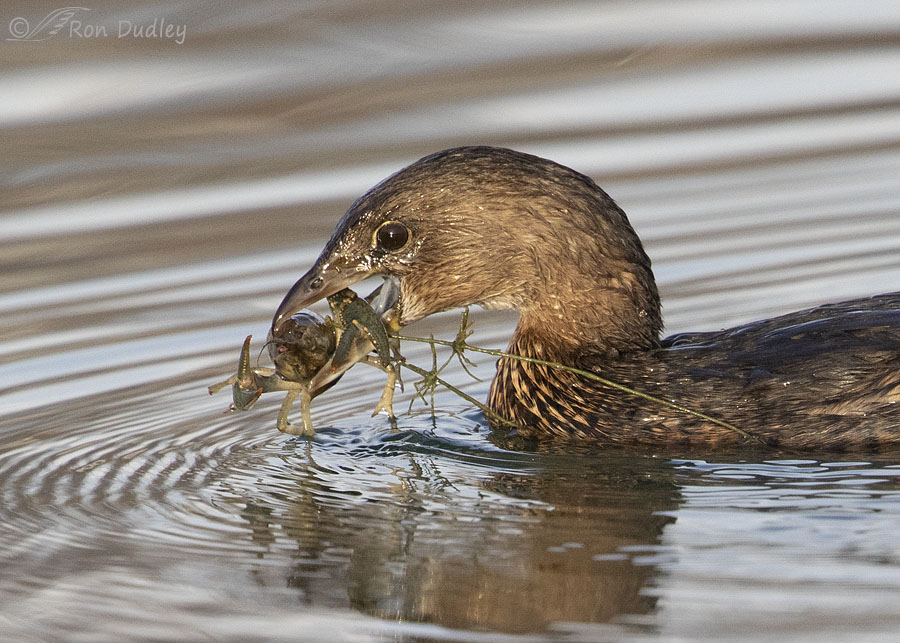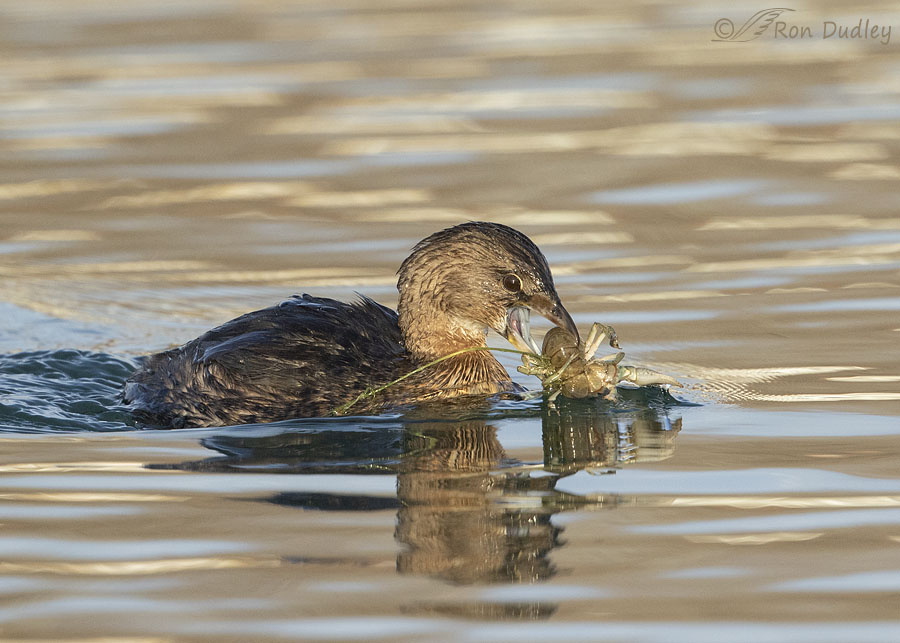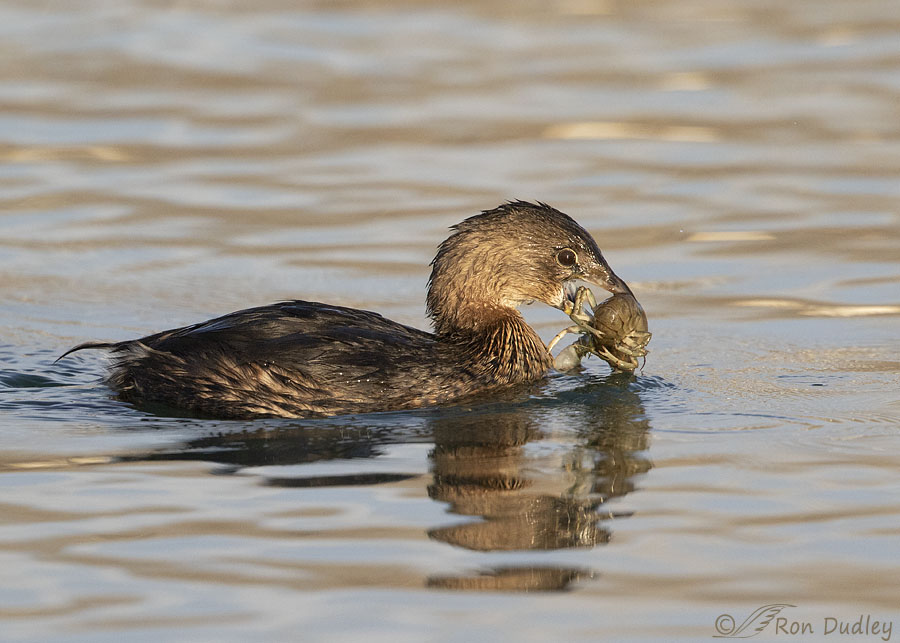When other kleptoparasitic birds are around there are easier prey to swallow than crayfish, especially with all their legs and defensive pincers.

1/2000, f/6.3, ISO 1250, Canon 7D Mark II, Canon EF 500mm f/4L IS II USM + EF 1.4 III Extender, not baited, set up or called in
Four years ago Pied-billed Grebes at a local pond were fattening up on crayfish and I had a front row seat. I cropped in tight on this photo to show detail because it was sharp and because the bird needed rotation and I didn’t have enough room in the frame to rotate and be left with an acceptable composition.
Every crayfish I’ve seen had black eyes but the right eye of this one appears to be red. It may look similar to the “red eye effect” in human subjects when a flash is used in low light to take the photo. These photos were taken in low light (thus my high ISO setting) but I didn’t use flash and the compound eyes of crayfish don’t have pupils so I’m assuming the red is just a reflection of some kind off the surface of the grebe’s eye. .

1/2000, f/6.3, ISO 1250, Canon 7D Mark II, Canon EF 500mm f/4L IS II USM + EF 1.4 III Extender, not baited, set up or called in
Seven minutes later another (or maybe the same) grebe had captured another crayfish. In both instances the grebe came up with plant debris in its bill along with the crayfish.

1/3200, f/6.3, ISO 1250, Canon 7D Mark II, Canon EF 500mm f/4L IS II USM + EF 1.4 III Extender, not baited, set up or called in
Pied-billed Grebes are dedicated kleptoparasites so when one grebe has prey other grebes typically try to steal it. So this bird was rushing to use some nearby emergent vegetation as cover before removing the pincers of the crayfish and then swallowing what was left of it in peace. As a result I never did see the grebe gulp it down.
Whenever I post photos that include crayfish the question of what to call them invariably comes up. Depending on geographical location, cultural influences and other factors crayfish may be called crawfish, craydids, crawdads, crawdaddies, freshwater lobsters, mountain lobsters, rock lobsters, mudbugs or yabbies.
But to me a crayfish by any other name is still a crayfish, even though they aren’t fish.
Ron


Even if you could eat in peace that looks like a spiky and difficult mouthful. Fending off thieves as well? It gives me indigestion just thinking about it.
EC, they don’t seem to have any trouble with it once they get the pincers off.
What an evolutionary marvel the gizzard is that enables the swallowing of a whole crayfish sans claws.
You’d probably get a sideways glance if you called it crayfish étoufée in Louisiana.
In Louisiana they take their “crawfish” very seriously!
Great photos (thanks for that tight crop). After reading your description of the “depincerization” procedure, I’m wondering if I shouldn’t feel just a little bit bad for the crayfish? But congrats to the Grebe for such an industrious effort to make a meal!
Chris, The ‘depinceration’ process is pretty interested. It’s so incredibly fast I never knew what they were doing until I finally photographed it pretty well a time or two.
wow, thanks for the description of how they deal with the pinchers. I was wondering how the heck they did that without getting pinched in the process. the whole deal makes me respect them all the more, as I do all the wild ones and how they manage to feed themselves against all odds. Thanks Ron!
Thank you, Karen. Where there’s a will (and enough hunger) there’s usually a way. I’m glad you found it interesting.
I second your comment!
Who knew?! Had to zoom into the first shot to see the head of the crawfish. Wonderful shots Ron.
Kathleen, I wish you could see as much detail as I can on the high resolution images.
Sounds like a painful way to go for the crayfish but the shots of the grebes are really sharp and make for a very interesting story and “behaviour” shots.
Thanks, Granny Pat. I’ve yet to see a grebe pinched by a crayfish but they’re obviously fearful of those pincers.
I think over the years I have used crayfish and crawfish, but mostly the first. Judy aptly described what I was thinking. What a job to rip that thing apart before being able to swallow it and also at the same time possibly have to fight off a thief. In all the times I have seen them here I have only seen them come up with fish. Excellent photos.
Everett, if crayfish are available and they aren’t too big they’ll take’em. They’re easier to catch but harder to deal with.
“Every crayfish I’ve seen had black eyes”. Thanks! Useful information for when I am tying my next bunch of “crawdad” imitation flies for catching bass. Interesting that Grebes like to have a little salad with their lobster lunch.
Porcupine, there are something like 640 species of crayfish in the world so I’m not saying they ALL have black eyes. But the one’s I’ve seen do have black compound eyes.
Love the shots!!
Thanks, Dick.
“Crawdads” is what I grew up with. That WOULD be a “delicate” operation to get rid of the pincers(they can give a decent pinch), keep the other grebes away, “slice and dice” and eat.
That WOULD be a “delicate” operation to get rid of the pincers(they can give a decent pinch), keep the other grebes away, “slice and dice” and eat.  Must be successful often enough to make it all worthwhile. Great close ups of the initial capture.
Must be successful often enough to make it all worthwhile. Great close ups of the initial capture. 
“That WOULD be a “delicate” operation to get rid of the pincers”
Judy, actually there’s not much “delicate” about it. They grab a pincer with their bill and then shake the hell out of it which amputates the pincer. Then they retrieve the body, which went flying, and do it again to the other pincer. Then, it’s lunch time.
Sending the body flying would be a great time for theft to occur!